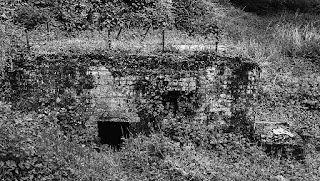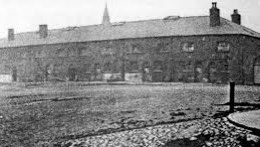Great Grandfather John Hedges, 1840-1905 (likely year of death…)
My great-grandfather was born in 1840 at Wonersh near Guildford and his father, also called John, of St Martha nearby was a gunpowder maker, presumably for the army.
 |
| WONERSH... |
My subject though actually joined the army in 1858 and he became a gunpowder maker too, for the East India Company, spending 20 years and 84 days in service, about half of it in the East Indies.
 |
| ST MARTHA, NEAR GUILDFORD... |
His father, John Senior appears to have been married twice, first to Eliza Bennett in 1835, then to Harriet Lemmon in 1847, the year after Eliza had died, aged just 31. My great-grandfather was either 11 or 13 in 1851, when the census listed them as living at St Martha, close to the gunpowder mills on the River Tillingbourne at Chilworth in Surrey.
 |
| GUNPOWDER MILL BUILDING ON ITS MOUND... |
 |
| NOT MUCH LEFT THESE DAYS... |
I have visited the church where John and Eliza were married, known as St Martha-on-the-Hill and their wedding day was 23rd April 1835, but it appears that after young John, 13, Eliza, 11 and James, 9, were born, Eliza passed away.
 |
| VIEW FROM ST MARTHA-ON-THE-HILL CHURCH... |
 |
| ST MARTHA-ON-THE-HILL, WHERE MY GREAT-GREAT-GRANDFATHER WAS FIRST MARRIED... |
 |
| INCREDIBLE VIEW FROM THE HILL... |
Harriet Lemmon then married John Senior and a daughter, Elizabeth, then a son, Thomas and another daughter, Harriet were born to the couple, although at that time, Harriet’s daughter, Louisa Lemmon was also living in the dwelling. She had been born at Albury.
On the Tillingbourne
(a poem for my great, great grandfather...)
I wanted to believe
That his worn, grimy boots,
Given a cursory polish
With cloth and blacking and phlegm
Had trudged this trodden way,
Grudging his weary day,
On a pilgrimage to St Martha’s-on-the-Hill.
I wanted to grieve
For his lung-dusting trade,
Proven a dangerous game
With sulphur and charcoal and saltpetre;
Millstones dressed to coarsely grind,
Regressing his wry mind,
At the foot of St Martha’s pilgrims’ hill.
I wanted to retrieve
There, my meagre, strained life,
Driven a torturous route
With loss and depression and need;
Intrusion released quite palpable tension,
Decreasing my wary distension
On the slopes and the beauty of St Martha’s hill.
I wanted to weave,
In this delightful, ancestral woodland
Haven, a milling link
With tributary and alder and burning;
Lives stressed by explosion fears,
Distressing their worry, their tears
During a funeral procession to St Martha’s-on-the-Hill…
Pete Ray
My great, great grandfather was a gunpowder maker at Chilworth…
Alder trees were set alight to produce the charcoal, which was mixed by milling with saltpetre and sulphur.
After my great-grandfather left the family home, it was by then at Hambledon Village Common, where John Senior was 46 and listed as a stoker, Harriet was 38, Elizabeth was 14, Thomas 12 and working as an agricultural labourer, whilst the latest editions were Mary, 9, Frederick, 2 and Rose, 1.
 |
| HAMBLEDON... |
John Senior lived to 60, passing away in late 1877, just two years before his son returned to England from India.
However, John Junior, the main character of this article joined the Royal Warwickshire 1st Battalion, 6th Regiment of Foot on 18th November 1858, being described as having a fair complexion, hazel eyes and dark brown hair. He was 5 feet 5 inches tall and his army number was 356…
 |
| ROORKEE, WHERE MY GRANDFATHER ALBERT WAS BORN... |
He was awarded four good conduct badges and a good conduct medal, with a £5 gratuity, although he possessed no school certificate. He spent 3 years and 278 days as a Private, until August 19th 1862, before being promoted to Corporal on 20th August. This rank lasted until 17th December 1866, when he was tried by court martial for ‘neglect of duty’.
 |
| PESHAWAR... |
This episode seems rather strange, for he was ‘confined’ for three days, 18th-21st December and was ‘reduced to the ranks’ at his trial, before his sentence was reduced, his forfeited pay restored and he was reinstated as a Corporal, all on the same day…
He remained a Corporal until 11th September 1868, then he was promoted to Sergeant on 12th September, before re-engaging in the army at Colchester ‘to complete 21 years of service’.
 |
| BOMBAY... |
He remained a Sergeant from 16th September 1868 until 10th February 1879, when he was granted his silver medal with a gratuity of £5 for long service and good conduct.
He had spent time at Colchester, Devonport, Calcutta, Barrackpoore, Bombay, Peshawara and Sealkote, as well as Roorkee where my grandad Albert was born. Barrackpoore is famous for an incident in 1857 when Indian soldier Mangal Pandey attacked a British Commander and was court-marshalled, resulting in Pandey’s Regiment being disbanded.
 |
| BARRACKPORE, 1865... |
Unfortunately, John struggled at times with his health, for fevers, ague and finally hepatitis plagued him. The hepatitis problem led to his discharge from the army, which was agreed on 18th December 1878. He returned to England with his family aboard the troop ship Seraphis on 19th March 1879, which took a fortnight.
 |
| THE TROOP SHIP 'SERAPHIS'... |
Having been so poorly with hepatitis, which was apparently due to the climate, although not aggravated by ‘vice’ or ‘intemperance’, he was soon treated at Netley Military Hospital, near Southampton.
 |
| NETLEY HOSPITAL... |
He was then posted to Warwick and in the 1881 census, he was listed as living at 4 Barracks Yard, St Mary’s in Warwick with his wife, plus daughters Elizabeth, Julia and Ada, plus Albert… John was described as a Staff Sergeant for the 1st Battalion of the Royal Warwickshire Militia and also a Chelsea Pensioner.
 |
| ABOVE AND BELOW: VIEWS OF BUDBROOKE BARRACKS, WARWICK... |
A move to 4 Court 5 Great Brook Street, Duddeston in Birmingham was next and by 1891 he was listed as a 49 year-old gunpowder maker, whilst my grandad Albert was just 13 and an errand boy/porter. New daughters Lily and Maud were listed too, as well as a domestic servant called Elizabeth Watts, aged 17.
 |
| ABOVE & BELOW: GREAT BROOK STREET BARRACKS, BUILT IN 1793... |
I wondered why the family had moved from Warwick Barracks to Great Brook Street in Birmingham and then I discovered that Great Brook Street had barracks, where soldiers were able to lodge, rather than attempting to find hotel or other accommodation.
 |
| GREAT BROOK STREET... |
John was 59 and described as a Pensioner on the 1901 census form, living at 144 Great Brook Street, although he had died by the time the 1911 census was taken, wherein his wife Elizabeth, a widow, was living with her daughter Julia at 2 Leamington Place, Willis Street, Ashted. It was likely that once her 'Pensioner' husband had died, she would be expected to leave Great Brook Street...
Interestingly, Julia’s surname hadn’t changed much from Hedges, for her husband was Samuel Hodges, a van man at a piano works…
BELOW:
4 STAINED GLASS IMAGES FROM ST MARY'S CHURCH, WARWICK, DEPICTING AND CELEBRATING THE ROYAL WARWICKSHIRE REGIMENT. NOTE THE DRUMMERS...















No comments:
Post a Comment